Chapter 1: The Renaissance and the Scientific Revolution
@@Major Time Periods in History@@
- Prehistoric : Appearance of humans
- Classical Era (600 B.C.-A.D. 476)
- The Middle Ages (A.D. 476 -A.D. 1450 )Medieval period
- Early Modern Era (A.D. 1450-A.D. 1750)
- Modern Era (A.D. 1750-Now)
==Movements of Early Modern Era==
- Renaissance Humanism
- Protestant Reformation
- The Enlightenment
- The European Renaissance
Features of Renaissance:-
Began in the 1300s
The period of transition from the Middle Ages to the Modern World
Tension Between Objectivity and Subjectivity
Began in Northern Italy
Derived from an Italian word meaning ‘rebirth’
Renaissance was the period when scholars ==broke free of the religion-based thinking== of medieval times toward a belief in the ==dignity and limitless potential== of human beings.
Two dominant institutions of the Middle Ages are
- Roman Catholic Church
- Holy Roman Empire
Throughout the Middle Ages, members of the clergy and theology dominated intellectual life. Catholic Church was closely involved in all aspects of life, social, political, etc. But over time scandals and abuses weakened the power of the papacy and the Catholic Church.
These conditions, freeing scholars from the religious and political controls of the Middle Ages, set the stage for a period of intellectual exploration that had lasting effects throughout Europe on education, art, science, religion and politics.
Features of Renaissance in detail
Revived Interest in the Classical World
Throughout the Middle Ages, monks @@had preserved@@ and @@studied many classical texts@@ in monasteries throughout Europe. Yet during the Renaissance, the revived interest in classical texts took a new form.
One ==major change== was that many Renaissance scholars were ==not members of the clergy.==
Italian Renaissance Humanists
Who were the Humanists?
Renaissance intellectuals who studied classical civilization and its texts were later called humanists because they focused on human beings and their inherent dignity.
- Scholasticism: Humanists who began to break free of the medieval philosophy
- Shift in Ideas about Religion: Humanists tended to emphasize different values than did medieval scholars.
- Humanists tended to emphasize different values than did medieval scholars rather than a life of penance aimed toward an afterlife.
- Growth of individualism: There was a focus on personal rather than institutional interests
Petrarch : Italian poet and scholar
- Father of Humanism
- Saw the Middle Ages as a period of darkness when knowledge of classical civilization was in decline
- He criticized medieval scholars for their inelegant use of the Latin language
- Though he loved Latin, he was among the first scholars of his era to write in the language of his region, Italian.
- He developed new philosophical approaches and scholarly methods of analyzing texts with a focus on the history of language.
- He also @@admired Cicero’s life@@ as an engaged citizen.
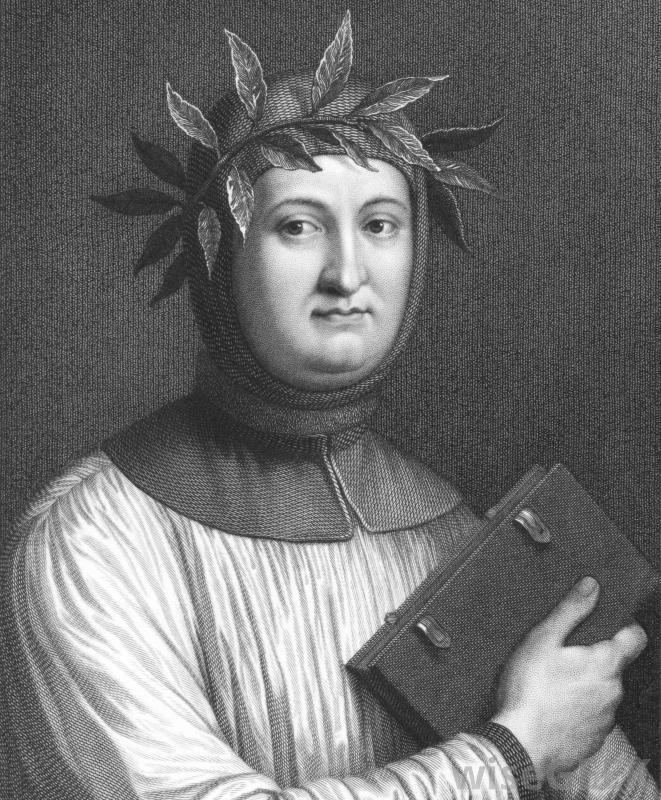
- He ==focused on how people behaved==
- He criticized medieval thinkers who had focused more on scholarly issues of logic than on everyday concerns of ethics.
Challenges to Institutional Power
Many classical Greek texts of philosophy and science had disappeared from Europe. However Arabic speaking scholars translated original Latin texts into Arabic, Aristotle was known as “==Aristutalis”.== When Europeans came closer to Arabs during the Crusades (a ==series of religious wars== between ==Christians and Muslims== started primarily to secure control of holy sites considered sacred by both groups in 12th century) , the texts became available in Europe but with limited access.
Educational point of view:
Some Renaissance humanists ==began to study Greek== so they could read classical texts in their original language.
The printing press was invented in @@1450@@ which surged the spread of books
With the spread of books and literacy, the earlier influence of universities and Catholic churches declined.
The focus was on Classical texts and new scientific methods of inquiry.
In 15th century, scholars expanded the revival of the interest in Greek and Roman texts by including literature, drama, and history.
The liberal arts of the 15th century began to be known as Humanities.
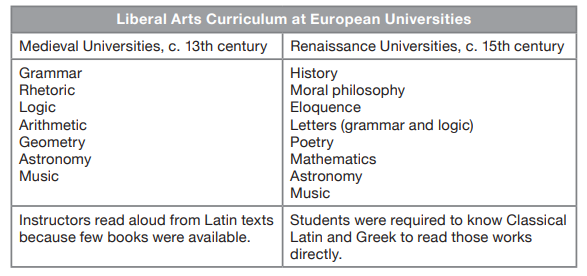
Humanists believed that education would
- help people achieve their full human potential
- prepare them to be active, productive citizens.
Effects on Education
- There was creation of secondary schools where Humanities was taught from an early age
- The universities continued to teach traditional fields of study but they too began to include Humanities
- There was an increase focus on the development of Renaissance man instead of scholars of medicine, law or theology.
Some of the famous Renaissance men are:
- Leonardo da Vinci (a painter, sculptor, botanist, mathematician, and so much more)
- Michelangelo Buonarroti (painter, sculptor, architect and poet)
- Raphael (painter and architect)
- Donatello ( prolific master of many sculptural forms)
Challenges to the Catholic Church
- The popes became concerned of the secular Renaissance culture
- They lost their spiritual authority
- Emergence of Christian Humanists in Northern Europe
Revival of Civic Humanist Culture
City States and its features
- The 15th century Italy was not a single country, instead it was a ==collection of city-states==
- These states were ruled by dukes and some were ruled by wealthy and influential families like the famous Medici family
- Invasions by French, german and Spanish forces caused instability and rivalry among these city-states
- Example of city-states in Italian province: Florence, Venice and Milan
Growing admiration for Greek and Roman Political Institutions
- As humanists studied classical texts, they developed a greater admiration for the Greek and Roman political institutions.
- Example: City-state was a common form of Greek and Roman societies..
- ==Athens and Sparta were the two biggest city-states.==
- Athens was the birthplace of democracy
- The Roman Republic was an early example of representative government.
Examples of Humanists who contributed in Renaissance
- Baldassare Castiglione: He wrote The Book of the Courtier, which outlines how to act like a proper gentleman or lady. It remained influential among the nobility for centuries.
- Niccolò Machiavelli: began serving as a diplomat for the republic of Florence, thus also becoming familiar with French and German politics. While earlier generations of diplomats had represented the Christian empire, Machiavelli observed that Renaissance diplomats worked on behalf of their own state.
Most famous work of Machiavelli : ==The Prince== (1513) provided advice for rulers.
Contents of The Prince
i. The Prince stressed ==the need for an absolute ruler== to use any means to achieve political unity and independence from foreign control.
ii. Machiavelli presented a ==cynical view of human nature== that required the prince to be feared rather than loved.
iii. He emphasized the ==importance of maintaining the power of the state== to provide citizens with peace and safety.
iv. To maintain stability, leaders often had to commit acts such as lying and bribery, Machiavelli explained, but ==should appear virtuous==.
v. A leader unwilling to act in such ways ==would fail to serve the community== and would soon lose power.
Yet, whether Machiavelli preferred Republicanism or despotism, The Prince has become identified with the belief that ==“the end justify the means,==” or that any methods, however evil or dishonest, may be used to achieve positive results.
The Printing Press Revolution
One of the many features of renaiasssance was the access to written works. Before the invention of printing press, books were copied by hand. Paper was first developed in china and was available in Europe by 12th century. Printing from carved wooden blocks began in Europe towards the end of 14th century. These blocks were used to print religious pictures and small amounts of text.
==The invention of Printing Press== was a revolution which was developed by printers over the first half of the 15th century in Europe.
@@Usage:@@ With this new invention, printers could compose whole pages of texts by creating lines of type from individual letters. Once a page was printed, the printer could take the type apart and reuse it.
==Gutenberg’s development==
A german printer, named Johannes Gutenberg devised a usable form of the new process. The hand operated wooden press was the beginning of a process of mechanizing printing and producing large quantities of books.
The first book printed was the Gutenberg bible, completed in 1456.
Printing then spread rapidly throughout Europe and within a few years there were printers throughout Germanic states of the Holy Roman Empire.
Printing Press and religious reforms
Renaissance humanism spread to northern Europe in the late 15th century, and northern humanists focused more on religious concerns than did their Italian counterparts.
By 1500, about half of the 40,000 titles that had been published were Bibles or other religious works.
Humanists especially desired to reform the Catholic Church but most of the works were written in Latin and had to be copied by hand which made such calls difficult to spread.
In 1517, a German monk named Martin Luther called for religious reform. He ==emphasized the Bible as the main source of religious truth and believed that people should be able to read and interpret the Bible themselves without the aid of priests.==
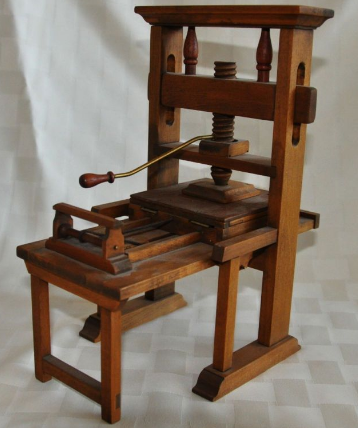
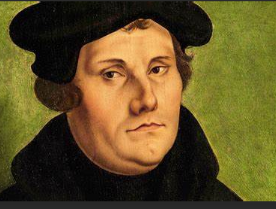
Luther’s ideas were translated in German, printed into pamphlets, and distributed throughout German-speaking lands.
Soon, many reformers added to the debate. The printing press ==allowed the ideas to spread faster and more widely than ideas had ever spread before.==
Within a decade, there was a revolutionary shift in European Christianity and politics, known as the famous Protestant Reformation.
Scripture readings became and important part of the Protestant services that %%were replacing the Catholic mass%%
Bibles were now ==available in vernacular or local language==. WIth the spread of printing, bibles were %%affordable%% and %%more easily accessible%%.
Renaissance Ideas in Visual Arts
- Artists of the Middle Ages had ==emphasized religious messages rather than portraying their subjects realistically.==
- Paintings looked %%flat and were decorative.%%
- Renaissance artists brought a fresh emphasis and style to the visual arts.
- Renaissance artists began to promote not only religion, but also personal, political, and religious goals of the artists and the patrons.
Italian Art and Architecture
Renaissance painters and sculptors incorporated new techniques and trends in their work.
Instead of symbolism of medieval painting, Renaissance artists tried to be more realistic in two ways:
- As artists observed the natural world more closely, they began to aim for naturalism in their works. Artists wanted to imitate nature.
- Artists mastered the technique of geometric perspective, which used mathematics to help them create the appearance of space and distance in two-dimensional paintings.
The Medici Family and Florence (The patrons of Italian artists)
- The patrons where the rulers and popes who commissioned works of art mainly to increase their own prestige.
Among the most prominent of these patrons were leaders of the Medici family (started Banking), which controlled Florence for decades.
Artistical feats from the Renaissance
The Church of San Lorenzo
- Cosimo de’ Medici commissioned Filippo Brunelleschi as architect for the rebuilding of the Church of San Lorenzo in Florence.
- the structure reflects the influence of Roman architecture with its use of classical columns and rounded arches.
- it is built to a more human scale than medieval Gothic cathedrals
- Brunelleschi also incorporated into the church the largest dome built since classical Rome.
Botticelli The grandson of Cosimo de’ Medici, known as “Lorenzo the Magnificent” (ruled 1469–1492), kept a large group of artists at his court, including Sandro Botticelli (1445–1520)
- Botticelli’s famous painting, Primavera(spring) displays the artist’s interest in classical mythology, featuring the figures of Venus, cupid, Flora and Mercury.
High Renaissance:
- It was the period between 1480-1520
- Renaissance art reached its peak, is called the High Renaissance
- The city of Rome became prominent as an artistic center.
- Three artists dominated this period- Michelangelo, Leonardo da Vinci and Raphael
Leonardo da Vinci
- Referred to as the model of the Renaissance man because of the range of talents
- He studied nature and conducted experiments, dissected human bodies to learn more about their structures.
- He also urged artists to move beyond the earlier emphasis on realism to a portrayal of human beings that earlier emphasis on realism to a portrayal of human beings that reflected their idealized or divine qualities.
Famous Paintings: The Last Supper and Mona Lisa
Michelangelo
Second leading artist of the High Renaissance
Sculptor. painter, architect and poet
In 1501, the govt. of Florence commissioned him to create the monumental sculpture -David, in which he portrays the biblical figure of David to reveal the splendor of the human form.
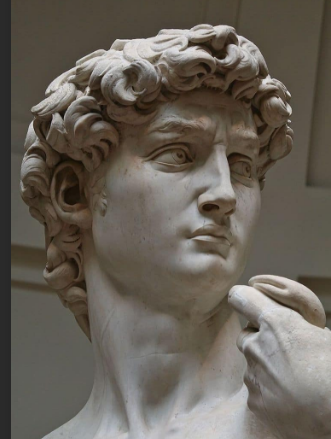
Also famously known for his architectural work- T==he “Sistine Chapel in the Vatican “==
In his paintings, Michelangelo focused on scenes from the biblical book of Genesis, showing humans as reflection of the divine.
Raphael (1483-1520)
Another artist who flourished under papal patronage
The Pope commissioned Raphael to paint a series of frescos in the Vatican Palace
Virgin Mary idealized her beauty
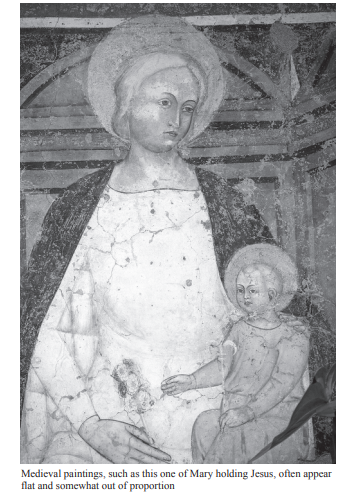
The Northern Renaissance
- When Renaissance Humanism and art spread to the northern regions of the Alps, later in the 15th century, it came to be known as Northern Renaissance
- It retained a more religious focus
- The naturalism of their art was more human-centered
- Artists considered individuals and everyday life as appropriate objects for their work.
- The artists in the North were less focused on the beauty of the human form and realistic settings and more on rendering exquisite details in the smaller works.
- @@Flanders@@ @@, now part of France and Belgium,@@
became the center of art in the north in the 15th century.
- The example could be seen in the work of Jan Van Eyck
- The northern artists did not display the skill of Italian artists in the use of perspective and proportion.
- After the Protestant Reformation, the no. of the religious works of art declined, as they became associated with idolatry and worshipping of physical objects of divine.
Mannerist and Baroque Artists
- In the 16th century, monasteries, city-states and the Catholic Church commissioned works of art to promote their own statue and power.
Artists continued to follow High renaissance principles by expressing themselves in new ways.
1. Mannerism
- The term started as a ==criticism==
- It came from @@16th-century@@ critics who thought contemporary artists were painting in the ^^“manner”^^ of Michelangelo and Raphael but lacked some substance.
- Mannerists artists did not break away from High Renaissance traditions, instead theyw anted to replace the principles of balance and harmony with more distortion and illustrious to add drama to their works.
- Mannerism spread from Italy to other parts of Europe.
- Reflected the spiritual and political turmoil following the Protestant Reformation in the 1520s and 1530s
- Eg. Work of El Greco, in his works, he elongated figures and used dark, eerie colors creating feelings of intense emotion.
2. Baroque
Around %%1570, Mannerism gave way to Baroque%%
- Beginning in Italy
- Baroque art and architecture brought together Renaissance classical traditions and the strong religious feelings stirred up by the Reformation.
- Departed from Realism and naturalism
- The art and architecture became important to Catholic rulers and clergy in Central and Eastern Europe and they started commissioning Baroque architecture and sculpture to stimulate religious devotion in their followers.
- The courts of Madrid, Vienna, Prague and Brussels were patrons of Baroque artists.
- The grand scale and splendor of their palaces were intented to reflect their power and evoke awe.
- Baroque art spread beyond central and southern Europe and included painting, sculpture and architecture.
- Eg: 1. ==Peter Paul Rubens and Gian Lorenzo Bernini==
Observation-Based Science
- Renaissance Humanism and art laid the groundwork for new ideas in science
- The emphasis on learning Greek led to scholars to read a broader range of classical texts, providing a @@source of ideas to challenge the existing worldview@@.
- The artists’ techniques to use mathematics to learn perspective, @@established a new way to learn about the world.@@
These new methods for studying the natural world were once the @@core of the Scientific Revolution@@, which developed slowly between the mid 16th and late 18th centuries.
New Ideas in Astronomy
- The word astronomy comes from the ancient Greek word meaning “arrangement of the stars.” It is a general term for the study of the universe beyond the earth.
- Cosmology is the branch of astronomy concerned with the origins and structure of the universe
Ptolemy
- Greek philosopher Aristotle and astronomer
- 2nd century BCE
- formed the basis of the worldview of medieval scholastic philosophers.
- Aristotle and Ptolemy portrayed a geocentric universe—one with the earth at the center of a system of concentric spheres, including the sun, circling around it. According to this worldview, the planets were bodies of light.
- Medieval scholastic philosophers accepted this view and, in line with their Christian beliefs, taught that God and the souls of those who had been saved existed beyond the outermost sphere of the system.
Nicolaus Copernicus (1473–1543)
- Polish mathematician and natural philosopher, a scholar who studied the physical world.
- s, Copernicus found references to ancient Greeks who questioned the geocentric views of Aristotle and Ptolemy and believed instead in a heliocentric, or sun-centered, universe.
- He proved that the perceived motion of the sun came from the earth’s spinning on its axis and its annual orbit around the sun
- He feared that other astronomers would criticize his heliocentric system.
- Therefore, he only published his work, only shortly before his death.
Later natural philosophers built on Copernicus’s work
Johannes Kepler (1571–1630)
- German astronomer and natural philosopher
- By analyzing precise measurements of planetary orbits, Kepler found them to be elliptical rather than circular.
- Copernicus’s still-controversial heliocentric model and disputed the religious belief (which even he had originally held) that the circle was the “perfect shape” and reflected the Divine order.
- Kepler shared his published work with the Italian mathematician Galileo Galilei in 1597.
Galileo Galilei (1564–1642)
- Galileo then extended Kepler’s ideas through use of a new method to observe the planets.
- Became the first European to build and use a telescope for this purpose
- Discovered details that had never been known, such as the moons that circled Jupiter as well as the craters on Earth’s moon.
- ==Galileo showed that the planets were not ethereal bodies but were similar to Earth in their composition.==
- Galileo’s book The Starry Messenger, published in 1610, reaffirmed the heliocentric system and brought wide attention to these new ideas.
- The Catholic Church rejected Galileo’s work and found him guilty of heresy. They placed him under house arrest until his death.
- Although Galileo retracted his ideas publicly, his works continued to circulate.
- Later, Galileo’s work on bodies in motion further challenged Aristotle’s views of the universe.
The Catholic Church’s condemnation of Galileo diminished the growth of science in Italy.
Isaac Newton (1642–1727)
- The scientist who later brought together the ideas of Copernicus, Kepler, and Galileo was the English mathematician, Isaac Newton.
- Among Newton’s many accomplishments was the discovery of the universal law of gravitation.
- Newton published his proofs for this law in Principia (1687), ==demonstrating that gravity applied to objects on Earth and in space and was the force that held the planets in orbit around the sun.==
- Newton saw the universe as a giant machine with God as the prime mover who set the planets in motion
Over a period of approximately 200 years, astronomers had developed a radical new cosmology, challenging the ideas of Aristotle and Ptolemy that were so widely held for about 1,400 years. Such rapid change in such fundamental beliefs shook the foundations of knowledge, but it was just an early step in replacing trust in tradition with reliance on observations and data.
Humoral Theory by Galen:
According to this theory, the body was composed of four humors, namely blood, yellow bile, phlegm, and black bile. Each humor had different combinations of the qualities of warm, cold, wet, and dry. According to Galen’s theory, disease was caused by an imbalance of the humors.
Challenges to Galen’s Ideas
Three physicians were most notable in challenging Galen’s theories:
• Paracelsus (1493–1531) used observation and experiments to develop a theory of disease based on chemical imbalances in specific organs that could be treated with chemical remedies in careful dosages.
• Andreas Vesalius (1514–1564) emphasized anatomical research, including dissection of the human body.
• William Harvey (1578–1657) corrected Galen’s ideas on the circulatory system, describing the body instead as an integrated system. Harvey’s experiments demonstrated that the heart was the starting point for the circulation of a single system of blood that makes a complete circuit through the body’s arteries and veins. Modern physiology is based on Harvey’s ideas.
The Scientific Method
As part of the Scientific Revolution, some thinkers promoted and laid the foundations for a more systematic approach on acquiring knowledge, that is the Scientific Method.
Scientific Method.: It is an approach based on observation, experimentation, and reasoning. It combines two different but complementary types of reasoning.
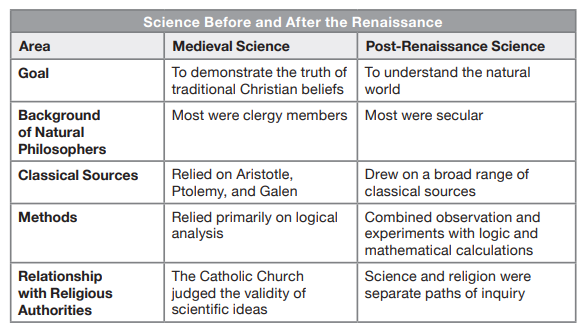
Persistence of Traditional Views
Europeans ==continued to believe that spiritual forces== governed the cosmos. Most scientists of the time believed in God and accepted a role for religion. Only later, in the 19th century, did people disagree over the boundary between science and religion.
Scientists of the 16th and 17th centuries also continued to accept two other traditional explanations about the world: alchemy and astrology.
• Alchemy was a medieval and Renaissance approach to chemistry primarily focused on discovering a method to turn common metals into gold. In a broader sense, alchemy was concerned with transformation and saw the world as filled with divinity.
• Astrology was originally synonymous with astronomy, but during the Renaissance it came to mean the study of the heavenly bodies as they influenced human activity.
==These traditional ideas continued to appeal to elites and to some natural philosophers.==
For example,
- Kepler studied astrology and was interested in the idea of a sacred geometry in the universe.
- Newton wrote extensively about his experiments in alchemy.
- Paracelsus’s view that a human being was a small reflection of a larger universe.
These traditional views persisted partly because, like the new science, they supported the idea that humans could understand the universe and make predictions about it.